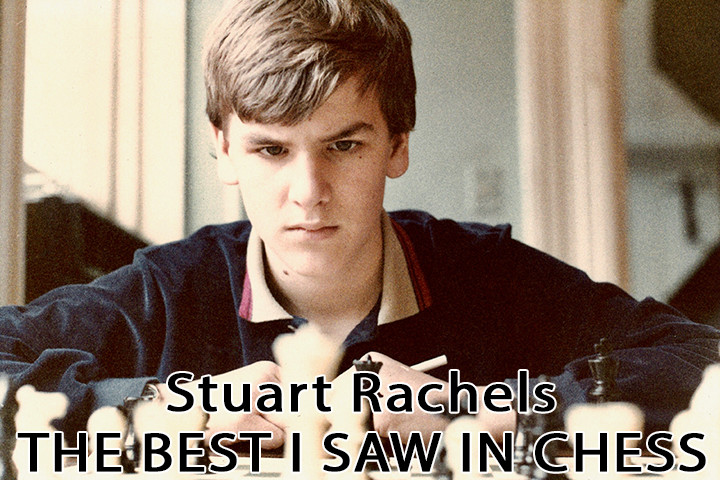
From the rear cover :
“At the U.S. Championship in 1989, Stuart Rachels seemed bound for the cellar. Ranked last and holding no IM norms, the 20-year-old amateur from Alabama was expected to get waxed by the American top GMs of the day that included Seirawan, Gulko, Dzindzichashvili, deFirmian, Benjamin and Browne. Instead, Rachels pulled off a gigantic upset and became the youngest U.S. Champion since Bobby Fischer. Three years later he retired from competitive chess, but he never stopped following the game. In this wide-ranging, elegantly written, and highly personal memoir, Stuart Rachels passes on his knowledge of chess. Included are his duels against legends such as Kasparov, Anand, Spassky, Ivanchuk, Gelfand and Miles, but the heart of the book is the explanation of chess ideas interwoven with his captivating stories. There are chapters on tactics, endings, blunders, middlegames, cheating incidents, and even on how to combat that rotten opening, the Réti. Rachels offers a complete and entertaining course in chess strategy. At the back are listed 110 principles of play–bits of wisdom that arise naturally in the book’s 24 chapters. Every chess player will find it difficult to put this sparkling book down. As a bonus, it will make you a better player.”

Stuart Rachels only had a short international career which came to an end almost 30 years ago. He’s now, like his late father James, a philosopher, specialising in ethical theory. Why, you might ask, does he deserve a 400+ page book? It seems rather like a vanity project, doesn’t it?
Let’s look inside and find out.
What you don’t get is a chronological account of the author’s career. Instead you get 24 chapters of varying length discussing a wide variety of aspects of chess and offering, in total, 124 games or extracts from his earliest efforts onwards. The book is also full of stories and anecdotes, many of which are highly entertaining. Rachels writes in a friendly style, alternating, perhaps slightly uncomfortably, between self-deprecating humour and arrogance: he might almost be sitting across the board from you explaining his games.
The first few chapter headings will give you some idea of what to expect: Losing Benonis to Kasparov, Five Stories and Their Positions, Two Rogue Sozins, Tactical Snippets, Beware the Sickly Pawns.
Yes, Rachels enjoyed tactics, favouring openings like the Sicilian Dragon and the Modern Benoni, while disliking the ‘rotten Réti’ and the English (‘Is there a Nobel Prize for Worst Opening as White?’), so you’ll see a lot of exciting play. At the same time, his trainer, Boris Kogan, played like Petrosian (‘You must play seemple chess’) and instilled in him a love of endings, again strongly represented here.
His opponents include many of his illustrious contemporaries, whom he met in international junior tournaments: you’ll find games against Anand, Ivanchuk, Gelfand, Adams and others here.
Although much of the book is US-centric, there’s also a lot to interest British readers. In 1983 Rachels spent some time in England, where, apart from playing in a simul against Kasparov, he lost a training match against David Norwood (‘the best tactician for my age I’ve ever known, aside from Anand’) which has its own chapter.
In the early 90s Rachels studied at Oxford University for two years: in the 1992 Varsity Match it was he who owned the aforementioned sickly pawns in a thrilling victory over Jonathan Wilson. After the game Ray Keene, suitably impressed, asked him to provide annotations. Rachels was surprised to see one of his sentences quoted verbatim in The Spectator. “Who would’ve suspected that the 44-year-old Brit cribbed that sentence off a 22-year-old American?”
There’s also a tense draw against Tony Miles (‘unpretentious, good-humored, and easy to be around’) from the 1989 US Championship. (Tony had satisfied the residency qualification by renting a post box in New York.) The ‘Foolish Drinker, Optimistic Patzer’ of the chapter heading is Rachels, not Miles. You’ll have to read it yourself to find out why.
In the final chapter Rachels offers his two best games. One played against his friend Kyle Therrell at the age of 11 (‘… might this have been the best game ever played by someone under the age of 12, as of March 29, 1981?’), and his win, given below, against Sergey Kudrin, again from the 1989 US Championship. If you buy the book you’ll be able to read his annotations.
The book concludes with three appendices. Appendix A explains adjournments (‘… a 20th century phenomenon, mostly occurring in high-level events’). Not in my part of the world: I had an adjournment from a local league game hanging over me at the start of lockdown: it was eventually agreed drawn via email. Appendix B, Principles of Play, offers some maxims which you may or may not find helpful, and Appendix C is what looks to me like a fairly arbitrary list of recommended books.
The format of the book does mean you miss the trajectory of his career, but at the same time the constant switching between topics will ensure you never get bored. Although Rachels is a relatively minor figure in chess history who retired nearly 30 years ago, he still has an infectious passion for chess, writes well, annotates lucidly and tells a great story. It’s often very funny too: a hugely entertaining and engrossing read which I thoroughly enjoyed. If you like games collections and biographies you shouldn’t hesitate to snap this one up.
Richard James, Twickenham 31st August 2020

Book Details :
- Paperback : 372 pages
- Publisher: New in Chess (7 July 2020)
- Language: English
- ISBN-10: 9056918818
- ISBN-13: 978-9056918811
- Product Dimensions: 17.02 x 2.79 x 23.37 cm
Official web site of New in Chess


I really hope that this wins the 2020 ECF Book of the Year. You can tell that a massive amount of work went into it. It’s that good.